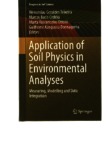Use este identificador para citar ou linkar para este item:
http://www.alice.cnptia.embrapa.br/alice/handle/doc/1012680| Título: | Spatial Relationships Between Soil Water Content and Hydraulic Conductivity in a Highly Structured Clay Soils. |
| Autoria: | VIEIRA, S. R.  GREGO, C. R.   TOPP, G. C.   REYNOLDS, W. D.   |
| Afiliação: | SIDNEY ROSA VIEIRA, IAC; CELIA REGINA GREGO, CNPM; GEORGE CLARKE TOPP, Eastern Cereal and Oilssed Research Centre, Agriculture and Agri-Food Canada; WILLIAN DANIEL REYNOLDS, Greenhouse and Processing Crops Research Centre, Agriculture and Agri-Food Canada. |
| Ano de publicação: | 2014 |
| Referência: | TEIXEIRA, W. G.; CEDDIA, M. B.; OTTONI, M. V.; DONNAGEMA, G. K. (Ed.). Application of soil physics in environmental analyses: measuring, modelling and data integration. New York: Springer, 2014. |
| Páginas: | p. 75-90. |
| Conteúdo: | The water, element essential for life, is present as a large reservoir in the soil. Soil water content varies in space as a consequence of the variability of other related properties and its study is necessary to know how this variation occurs in space and time. The objective of this study was to assess the spatial and temporal variability of soil water content and its relationships with hydraulic conductivity. Soil water content was measured with a TDR equipment and the hydraulic conductivity was measured with a constant head well permeameter at 15 and 50 em depth, in a nearly flat 1.2 ha field at the Central Experimental Farm of the Agriculture Canada, Ottawa. The soil is classified as a Rideau soil series, is primarily clay to silty clay texture. Sampling was made on a 10 m spacing square grid with 164 sampling points. Soil water content was measured on 33 dates during the frost free months in 1987, 1988 and 1989. The rate of change in soil water content was calculated for the periods which did not have any rain. The spatial variability was analyzed examining the descriptive statistical parameters, the parameters of the models fitted to individual semivariograms as a function of time and the maps obtained by kriging interpolation. It was concluded that soil structure played a very important role on the spatial distribution of hydraulic conductivity and water content. Temporal stability of water in the soil is quite different during the year probably because of the hydraulic conductivity role. Parabolic trend removal |
| NAL Thesaurus: | Geostatistics |
| Palavras-chave: | TDR temporal stability Semivariogram |
| Série: | (Progress in Soil Science) |
| Tipo do material: | Parte de livro |
| Acesso: | openAccess |
| Aparece nas coleções: | Capítulo em livro científico (CNPM)  |
Arquivos associados a este item:
| Arquivo | Descrição | Tamanho | Formato | |
|---|---|---|---|---|
| 4427.pdf | 9.47 MB | Adobe PDF |  Visualizar/Abrir |









